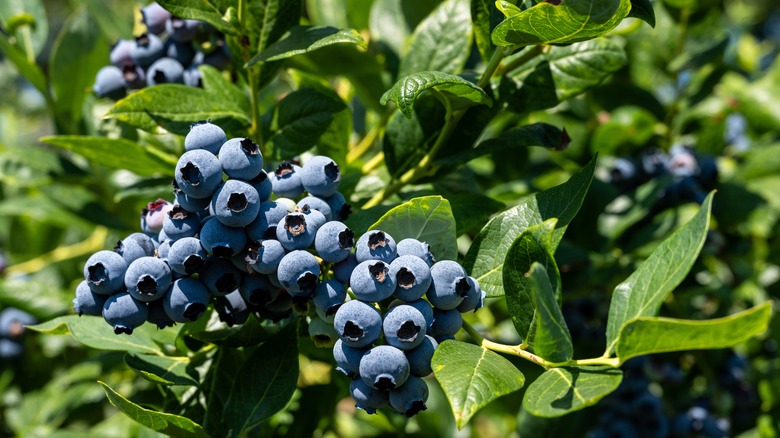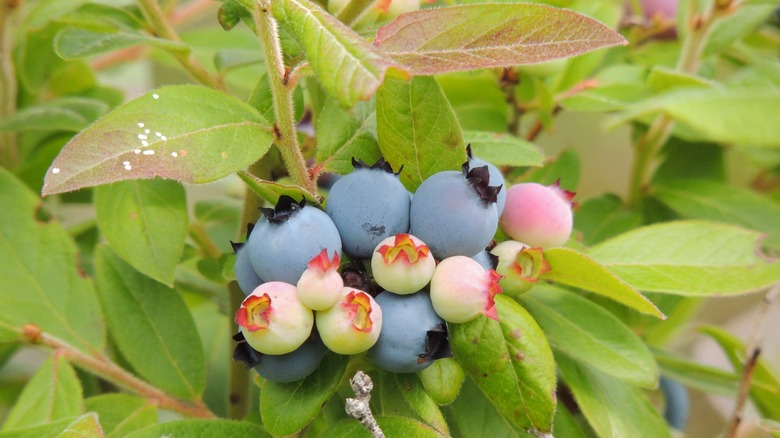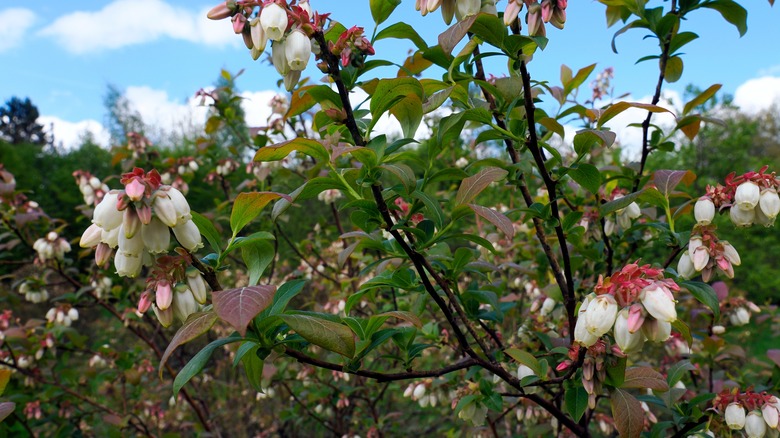Wild Blueberries Vs Cultivated: What's The Difference & Which Are Best To Grow?
In their native home of North America, blueberries are considered one of the most quintessential summer fruits you can grow (or buy). From smoothies to pies to muffins and pancakes, it's hard to imagine a summer outdoor brunch or breakfast in bed without the tart sweetness and vivid color of blueberries. While the delicious taste and distinctive coloring of blueberries is no secret, there is a bit of an unknown fact about this fruit: some blueberries are wild and some are cultivated. Can wild blueberries be planted and grown intentionally? Technically, yes, but this is no easy feat.
Wild blueberries are exactly what they sound like. They grow naturally — mostly in Maine and Eastern Canada — in cold-climate areas that have been disturbed by natural events, such as fires, without ever being planted intentionally by humans. These berries grow in such tough conditions that a natural field of them is referred to as a blueberry barren. As a result of their tenaciousness, they contain more flavorful skin and higher quantities of nutrients. If this tempts you to try to grow them yourself, however, you might end up disappointed, as it is much easier to grow and care for blueberry plants of the cultivated variety.
Wild blueberries vs. cultivated blueberries: delicious differences
Indigenous North American wild blueberries have grown in nature for thousands of years. While humans now have a hand in creating the soil disturbances needed for these blueberry plants to thrive and in the harvesting of their fruit, people do not generally plant them or control where they grow. Mother Nature produces these berries on her timeline; humans are just smart enough to keep showing up to enjoy their benefits.
Cultivated blueberries, on the other hand, are purposefully planned, planted, and cared for by humans, and a blueberry bush can thrive in the garden environment. They are tall and known as highbush blueberry plants, whereas wild blueberries grow low to the ground on "lowbush" plants. Cultivated blueberries are typically much larger and more uniform in size than wild blueberries. While this may make them more aesthetically appealing, it lends nothing to their nutritional value or flavor. The increased size of cultivated blueberries in mostly due to a higher quantity of pulp and water as opposed to wild blueberries' thicker skin and lower water content. Nutritionally, wild blueberries are far superior, containing more fiber and double the antioxidant capacity of cultivated blueberries.
The reality of attempting to grow wild blueberries
It is possible to plant and grow wild blueberries intentionally? Yes. However, possible and practical are two different matters. Wild blueberries require very particular conditions to thrive, and the growing zones depend on the individual cultivars. This includes a cold climate, acidic, sandy and well-draining soil, regular soil disturbances, full sun exposure, lots of space away from garden plants for horizontal growth, and an abundance of pollinators.
While growing from seed is an option, you can also purchase blocks of sod from wild blueberry patches in Maine and transplant them. It is recommended to prune new growth for the first two years as the new wild blueberry patch establishes its roots. Then, you'll need to begin a two-year cycle of disturbances. One year, half of the patch will need to be mowed (or burned, if it is far enough away from structures) and the other half can be harvested. The next year, the other half should be disturbed while the first half is harvested.
Cultivated blueberries, in comparison, can grow in warmer and more widespread climates and conditions. While still requiring acidic and well-draining soil, these bushes grow neatly in rows and don't require as much horizontal space or regular soil disturbances. Instead, simply prune your blueberry bushes in summer. If you're looking for the easier blueberry to grow, cultivated is the answer. For those seeking a challenge or willing to sacrifice ease for nutritional value, it my be worth attempting to being wild blueberries home.


